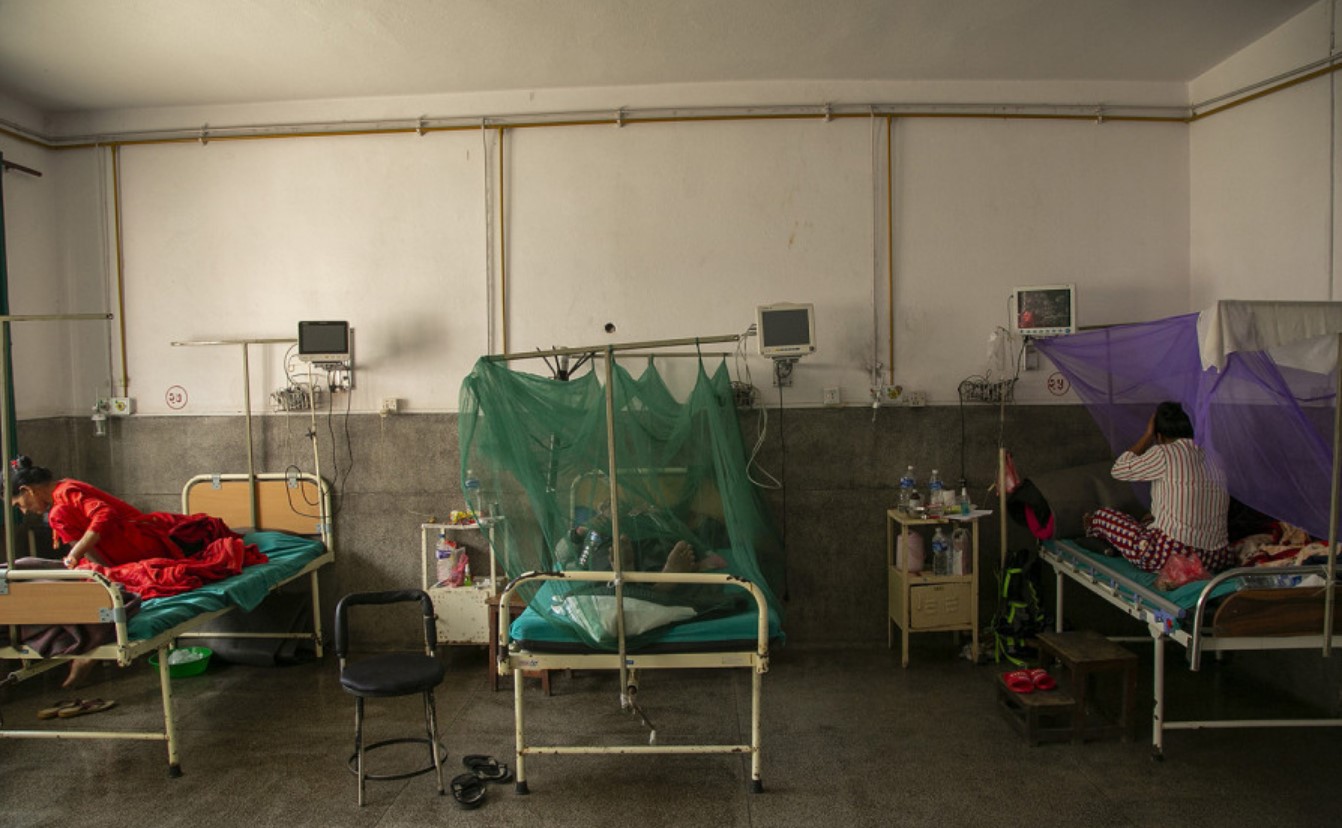
Seriously ill patients at District Hospital Sankhuwasabha are squeezed into every available space besides the beds: corridors, the floor, chairs, and even the storeroom, and outside on the hospital compound.
With the spike in new cases of water-borne, viral fever and vector-borne diseases, mostly dengue, the hospital is struggling to cope.
“Every day, around two dozen seriously ill patients end up sleeping on the corridor floor and in other areas,” Dr Pranam Jayaru, medical superintendent at the district hospital, told the Post over the phone from Khandbari, the district headquarters. “Our health workers have been working overtime to provide care, but we lack even the most basic supplies like IV stands. Patients’ visitors have to hold the IV bags or we have to improvise by tying them to windows.”
This situation is becoming increasingly common in hospitals in many districts, which are seeing a spike in patient numbers amid a massive dengue outbreak.
The virus has spread to 75 of the country’s 77 districts, killing at least three people and infecting 5,119 others since January.
Two mountain districts—Humla and Mustang—have yet to record dengue cases this year.
“For the last three years, we have witnessed a dengue epidemic during the monsoon season,” said Jayaru. “We can only request our staff to serve extra hours, but cannot provide equipment or expand bed numbers.”
Doctors say most patients do not want to be referred to other places, as reaching Dharan, the nearest city, in an ambulance takes over six hours. Holding seriously ill patients in ill-equipped hospitals is risky as they lack consultant doctors, blood transfusion services, and high-tech laboratories, among other things.
Experts say the deadly virus outbreak in most mountain districts and all hill districts shows the impact of climate change on Nepal’s healthcare system. Despite these challenges, no effective mitigation measures have been adopted.
Many hospitals are overwhelmed by the influx of patients, and health workers are forced to place seriously ill patients in corridors and other makeshift spaces, compromising patient safety.
“Our health facilities are not equipped to endure the climate crisis,” said Dr Meghnath Dhimal, chief researcher at the Nepal Health Research Council. “Many are built on hilltops or riverbanks, both vulnerable to climate impacts. These health facilities are also unprepared for emerging problems and spiking patient flow.”
Of the 5,119 cases of the dengue cases reported, only 77 cases are from Madhesh Province, which is traditionally an endemic area.
Health Ministry officials admit that the disease is shifting towards hills and mountain regions due to climate change. They say other factors, such as increased mobility and improved transportation, are also contributing to the spread of the disease to new areas.
“Yes, new challenges have increased in areas previously considered less risky, but we have not strengthened our health facilities to deal with the emerging challenges accordingly,” said Dr Gokarna Dahal, chief of the Vector Control Section at the Epidemiology and Disease Control Division. “Our health system is not is not designed to address these evolving risks.”
Dengue is a viral disease transmitted by female Aedes aegypti and Aedes albopictus mosquitoes. According to the World Health Organization, the same vector also transmits chikungunya, yellow fever, and the Zika virus.
In 2023, at least 20 persons died, and more than 52,000 were infected by the virus across the country.
In 2022, a total of 88 people died, and over 54,000 were infected by the virus. During that period, hospitals in the Kathmandu Valley were overwhelmed with dengue patients, and pharmacies ran out of paracetamol, the most widely used medicine to treat fever.
Back in 2019, dengue killed at least six people and more than 16,000 were hospitalised across the country. The virus had spread to 68 districts at the time.
Dengue has become a year-round threat in Nepal over the past few years with cases consistently rising each year.
Epidemiologists as well as virologists now consider the dengue virus as a major public health problem in Nepal. They also say that despite thousands of persons getting infected and scores dying from the disease, the authorities have not taken the situation seriously. The lackadaisical approach, they believe, is contributing to the spread of the virus. They call for implementing measures such as search-and-destroy drives and awareness campaigns to control dengue vectors.
A report by the United Nations titled “Climate Change 2022: Impacts, Adaptation and Vulnerability” states that at least six major vector-borne diseases have recently emerged in Nepal and are now considered endemic, with climate change implicated as the primary driver.
The report also showed increasing evidence that climate change has extended the elevational distribution of Anopheles, Culex and Aedes mosquitoes, which carry viruses to above 2,000 metres in Nepal.
Dengue-transmitting mosquitoes breed in clean water and bite people in daylight. Uncovered water tanks and other discarded objects such as plastic cups and bottles could be breeding grounds for the dengue-carrying mosquitoes.
Symptoms of dengue include mild to high fever, severe muscle pain, rashes, severe headache and pain in the eyes, doctors say. Patients with these symptoms are advised to seek immediate treatment. While there is no specific cure for the disease, early detection and access to proper medical care can prevent death.












